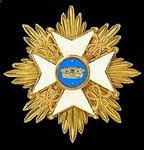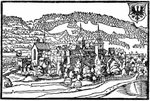
 Effern was part of the contribution of the elector (Kurfürst) of the Pfalz to
Effern was part of the contribution of the elector (Kurfürst) of the Pfalz to  the Reichsarmee. First raised 1690, Effern consisted of 1 contingent, with 2 battalions (a total of 8 companies of musketeers, each company c.137 men) with 2 grenadier companies (each c.100 men). The total was therefore around 1296 men. The regiment had 2 4 pounder cannon in May 1758. From 23.5.1755-17.8.1769 the colonel was Josef, Graf von Effern. The regiment missed Rossbach as it was on detached service. It was with the Reichsarmee at the taking of Torgau in August 1759 and Maxen in November 1759, and stayed with the Reichsarmee until at least June 1760. It was certainly not at Freiberg 1762 where the Reichsarmee distinguished itself.
the Reichsarmee. First raised 1690, Effern consisted of 1 contingent, with 2 battalions (a total of 8 companies of musketeers, each company c.137 men) with 2 grenadier companies (each c.100 men). The total was therefore around 1296 men. The regiment had 2 4 pounder cannon in May 1758. From 23.5.1755-17.8.1769 the colonel was Josef, Graf von Effern. The regiment missed Rossbach as it was on detached service. It was with the Reichsarmee at the taking of Torgau in August 1759 and Maxen in November 1759, and stayed with the Reichsarmee until at least June 1760. It was certainly not at Freiberg 1762 where the Reichsarmee distinguished itself.
In his discussion of Palatinate uniforms in Pengel and Hurt's Bavaria, Saxony and Palatinate Supplement (1981) Martin Lange argues convincingly that Palatinate infantry were clothed in dark blue during the Seven Years War, apart from Effern, IR No.3, which was in a much lighter blue. When in 1777 the Palatinate troops were absorbed by Bavaria, the Palatinate infantry all switched to light blue coats like those of Effern, and in 1783 the Bavarian infantry followed suit.
The red facings come from earlier (and even some recent) published material but it seems highly likely that white facings (on the right) are more accurate. I prefer the look of the red myself but... Yellow buttons were introduced sometime between 1759-1777 but it is not known if the change took place during the SYW so I have shown them as white metal as they would have been until at least 1759.
Saturday, 9 May 2009
27th Reichsarmee Template - Musketeer of the Infantry Regiment Effern (Electoral Rhenish Circle)
Posted by
David Morfitt
at
Saturday, May 09, 2009
![]()
Subscribe to:
Post Comments (Atom)


















I prefer the cornflower blue, it just seems better...
ReplyDeleteAh, nothing like light blue and red with a three-cornered hat and gaiters. It reminds me of Brigadier Young's Erbprinz Regiment in Charge. David, you've made my day!
ReplyDeleteBest Regards,
Stokes
I agree, Bill, but it does seem that the light blue for both Palatinate and Bavarian troops is mostly not authentic for the SYW! D**n those sources... ;-)
ReplyDeleteDavid.
Absolutely, Stokes, red and light blue is a wonderful combination. At least for ImagiNations authentic is what *you* decide for your own troops. ;-)
ReplyDeleteI'm glad you like it so much. :-)
David.
Nice work as usual!
ReplyDeleteI'm learning quite a bit from the colored versions and the information you are including. Thanks! :-)
Thanks, FB. :-) I'll have to force myself to keep doing the texts, then - I always feels a bit irritated not to be able to launch straight into drawing the next template. At least if people like the text too it gives me an incentive...
ReplyDeleteDavid.
Absolutely, the text is essential.Get motivated...
ReplyDeleteI've come to this argument rather late David, but (and this is a BIG but - perhaps its my own big butt?) I have a video tape, recorded from Bavarian TV via satellite, which shows a Bavarian uniform, copied from German museum archives and worn by a modern day re-enactor, of the 1710 period (a bit early perhaps) but it IS of a lightish blue colour - and definately NOT dark blue.
ReplyDeleteOK, so the Bavarian uniform might have gone from light blue to dark blue, and then back to light blue again, but it doesn't seem logical to me. Just a thought.
Steve.
Hi Steve,
ReplyDeleteWell, it seems to me that the documentary evidence is strong for dark blue - if you'd like to know what it is, let me know and I'll let you have details.
The problem with artefacts is that over several hundred years non-fast vegetable dyes can change a great deal so I'm afraid the "real thing" is not necessarily good evidence, paradoxical though that might seem. :-)
Thanks for commenting.
David.
Fading of old paints and dyes indeed make contemporary painting and artefacts not totally conclusive. For instance the French Bleu de Roi seems to have darknened steadily during the 18th C., from the light-medium blue worn by th Gardes Françaises as painted by Delaistre, to the rather dark Bleu National of the Revolution. But does this merely reflects the fading of sources with age?
ReplyDeleteRegarding the SYW Bavarians (by opposition to the Reich contingents) in dark blue, I’m aware of the debate (threads on TMP, Yahoo groups, comments on ‘Templates for the Ages’) and yet I’m not totally convinced. Bavarian light blue is well supported (with the reservations above) in earlier dates including in heraldry, and is ascertained later: why this transitory dark blue?
One piece of evidence is that Bavarian officer doing a cloak over his coat ‘not to be mistaken for a Prussian’: but he was mounted, and Prussian Dragoons wear light blue coats. Chiefly there is a single painting, but I wonder: how long the regiment has be campaigning? Long time far away from its base, with erratic logistics? There is a mention that some Bavarian infantry ended the war with coats deprived of the traditionnal lace: was not this dark blue uniform an ersatz field replacement, taylored with the most readily available / cheapest blue cloth available on the spot? Then Bavarians in dark blue, just like Frenchs in Spain dressed with ‘monk’ brown cloth, would be ‘historically accurate’ but some kind of ‘historical accident’. Accurate but not representative of the ‘theory’; such ‘historical accident’ -parochial rather than universal- wargamers can dispense with mirroring, *any* wargame being ‘alternate history’ (how historically accurate the background, setting, initial TEO, deployment… as soon as you *play* Frederick can be killed at, the Pretender can win at Culloden, you are potentially generating ‘alternate history’). In the time-line you are gaming, historical accidents’ of ‘our’ time-line may well have not happened… So, if you prefer your Bavarians in light blue…
Hi Jean-Louis,
ReplyDeleteThere is rather more evidence than that; see the Pengel and Hurt Bavaria, Saxony and Palatinate Supplement. It is all consistent with dark blue for Bavaria and the Paltinate for the SYW period and beyond. I feel convinced by it. Of course, any ImagiNation painter can do whatever he or she likes!
Capricious and illogical changing of uniforms is well known for many nations and times, so I don't feel that is a terribly good argument against a transitory period of dark blue uniforms. ;-)
All the best,
David.